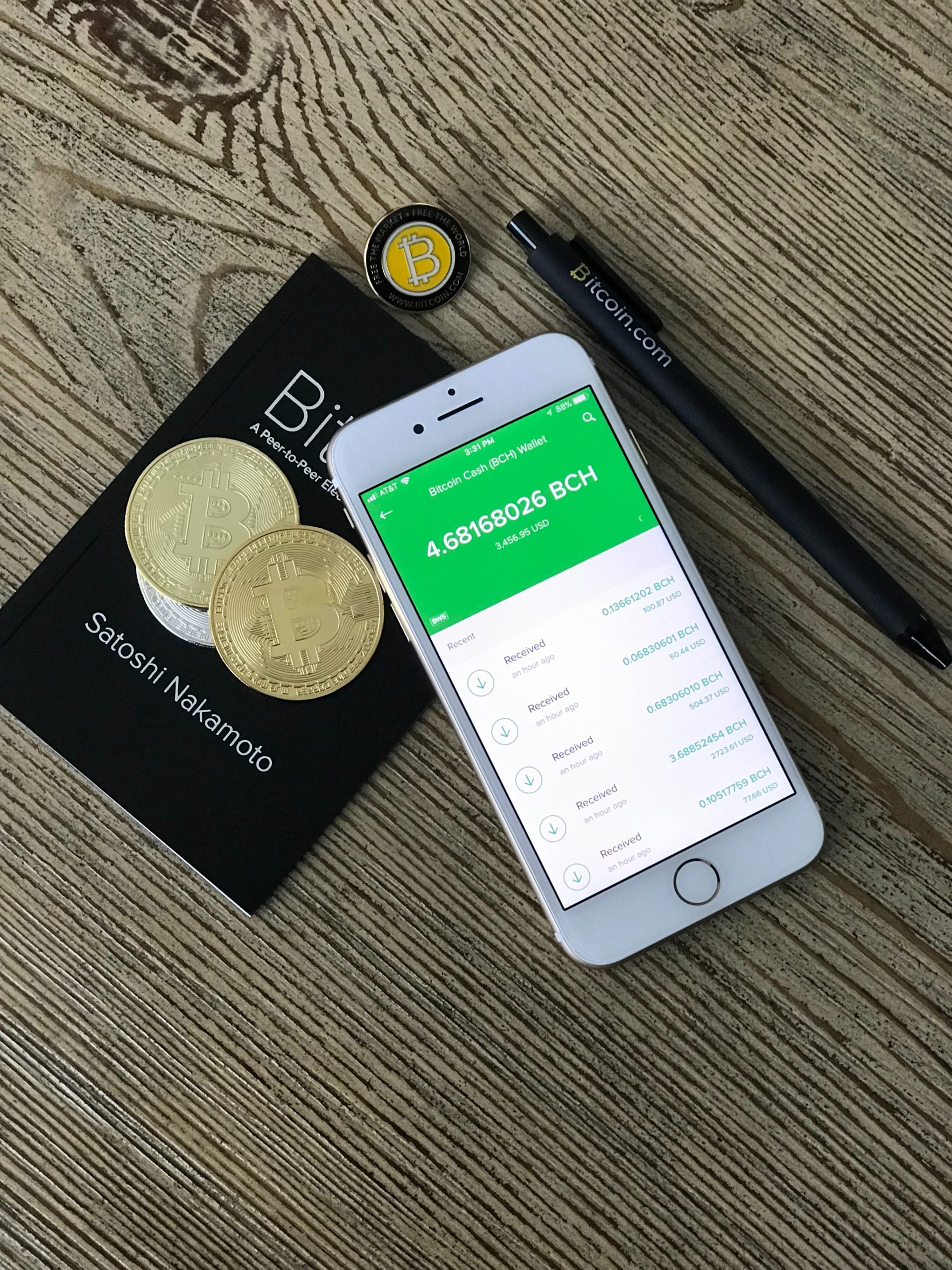On August 1st of last year, Bitcoin Cash forked from Bitcoin. When it launched, its developer community promised to realize a vision for digital cash that they felt Bitcoin itself had failed to deliver: a decentralized, high-volume payment system with low enough fees for anyone to use.
In the week from April 17th to April 24th, the price of Bitcoin Cash doubled from about $750 USD to about $1500 USD. In that same period, Bitcoin’s price increased only 15%, from ~$8100 USD to ~$9400 USD.
Bitcoin Cash advocates heralded this rally as BCH making good on its promise.
So, has Bitcoin Cash done what it set out to do? Is it better than Bitcoin? Do we have enough data to even answer these questions? How far has BCH really come from the hard fork nine months ago?
Let’s see how BCH stacked up against BTC back when they first forked:
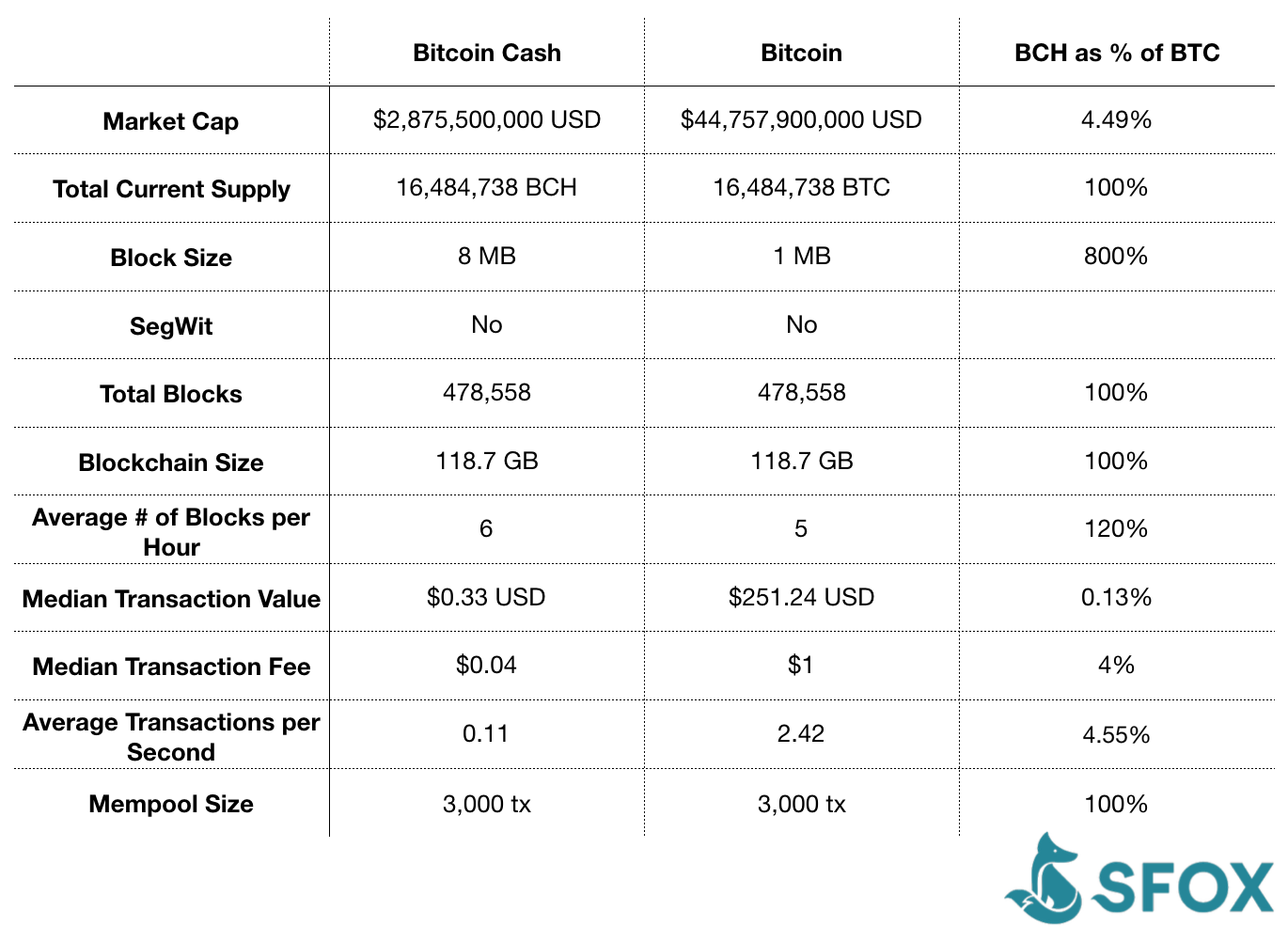
Here’s how that compares to where the two are today (as of May 7, 2018):
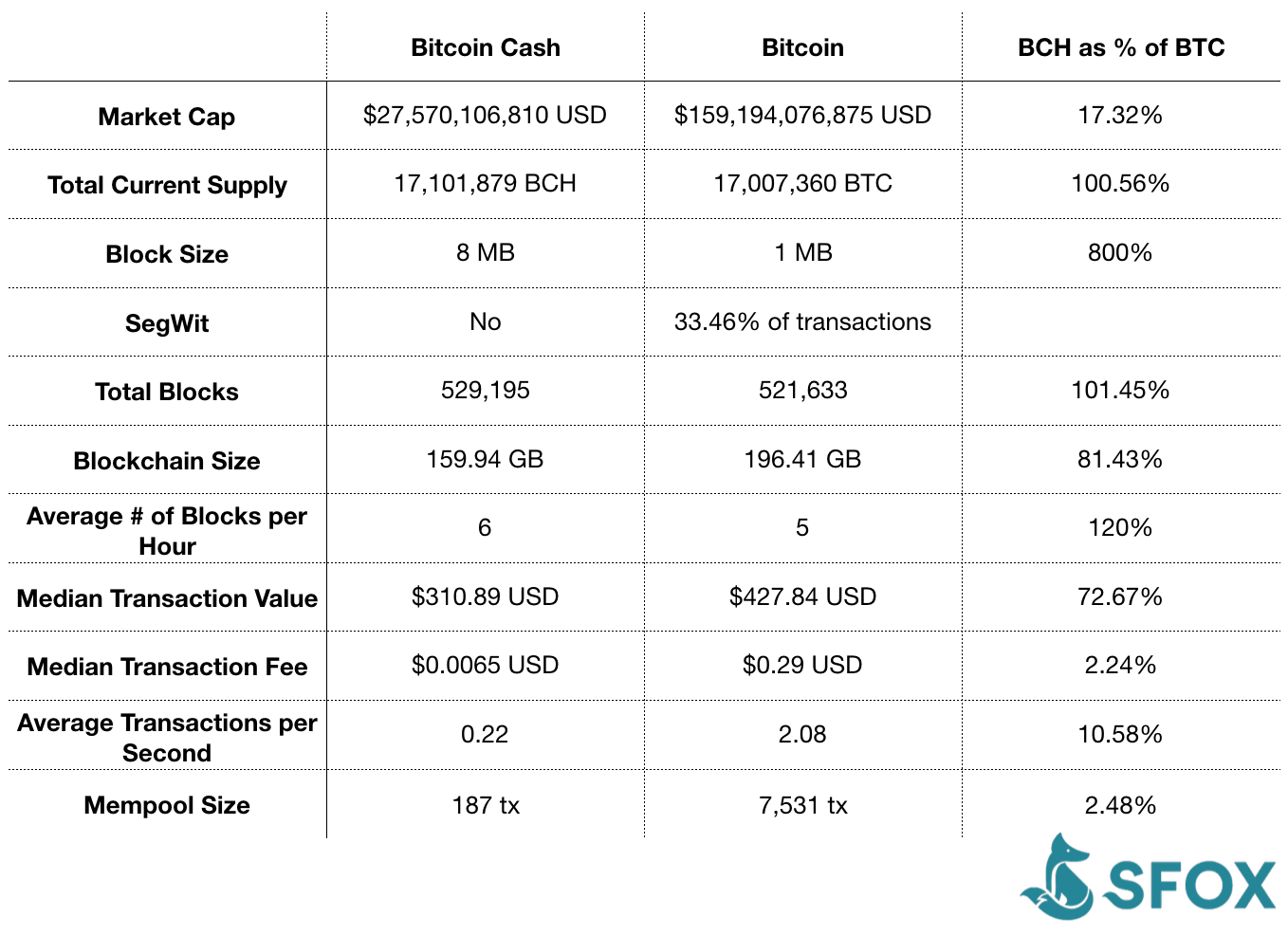
To understand what these numbers say about how BCH has grown and how it hasn’t, we need to compare BTC and BCH across three dimensions:
- Block size. How have BCH and BTC found their own solutions to the problem of scaling?
- Transaction volume. What can current transaction volumes teach us about whether and how people are adopting BCH vs BTC?
- Mining. How does the shared community of BTC/BCH miners influence the relationship between BTC and BCH?
Examining these dimensions makes it clear that Bitcoin Cash hasn’t quite yet realized its lofty aspirations yet, though it has made important structural decisions that are setting it up to be very different from Bitcoin in the years to come.
BCH’s bigger blocks haven’t mattered yet
Right now, Bitcoin Cash’s 8-MB block size limit is eight times as large as Bitcoin’s (non-SegWit) 1-MB blocks. Today, Bitcoin Cash’s block size limit will increase to 32 MB — 32 times as large as Bitcoin’s.
From the hard fork onward, the drastic difference in size between BTC’s 1-MB blocks and BCH’s 8-MB blocks has been a key differentiator between these networks. BCH’s bigger block sizes mean that it can currently support far more transactions than Bitcoin can in the same amount of time.
While transaction volume now on BCH isn’t close to what it can support, the block size debate shows how differently both networks think about scaling. While Bitcoin Cash supporters like to identify bigger block size with cheaper, faster transactions, the Bitcoin camp views Layer-2 solutions as a better method of scaling.
Bitcoin Cash supporters believe that bigger block sizes will ultimately lead to a network that anyone can transact on — a network that can serve as a “PayPal 2.0.” The average transaction size for Bitcoin Cash is about 200 bytes, which means that each of the network’s 10-minute, 8-MB blocks could support (on average) 40,000 transactions, for a total of 5,760,000 per day. In contrast, BTC’s 1-MB (non-SegWit) blocks can each only support 5,000 transactions of the same size, for a total of 600,000 per day.
But even though BCH is built to handle huge numbers of transactions, it’s only had 19,799 transactions in the past day — just 0.34% of the daily transaction volume it can support.
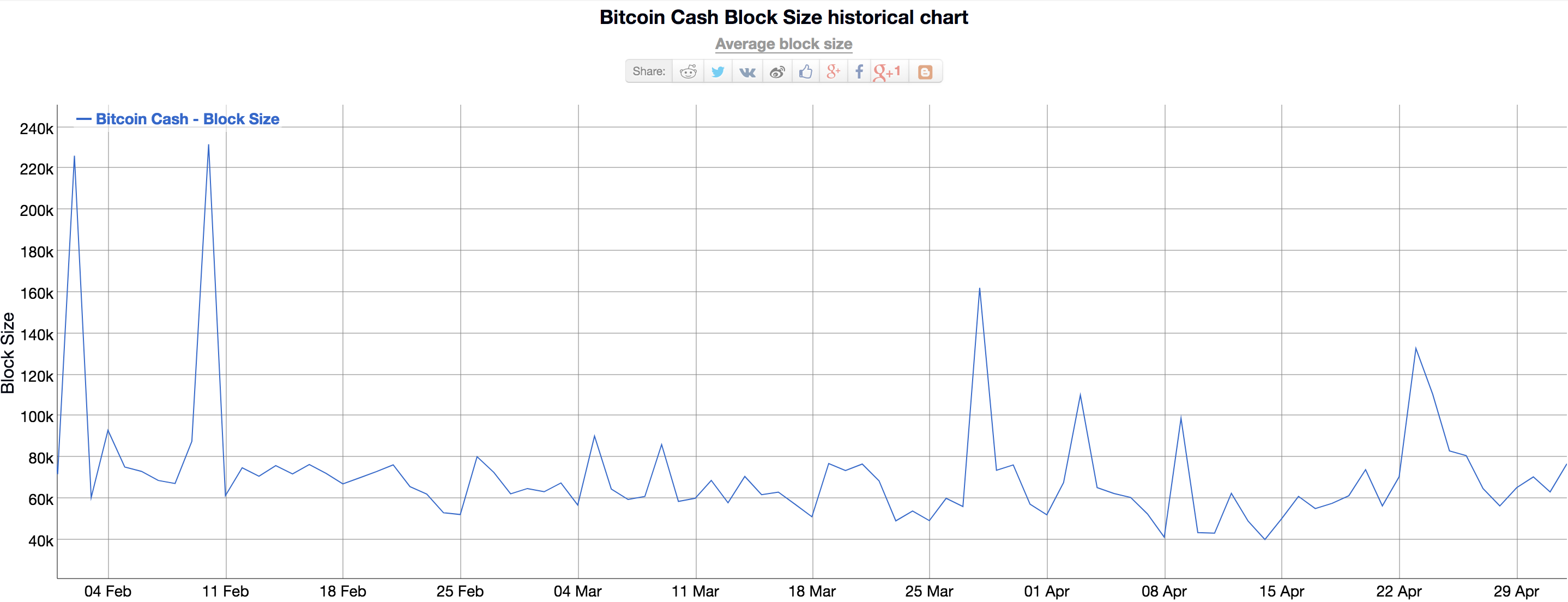
Although BCH is nowhere near its block size limit yet, Bitcoin Cash developers are doubling down by making the cryptocurrency’s blocks even bigger: today, BCH is undergoing a fork increasing its block size limit to 32 MB. According to Bitcoin ABC, the developer team orchestrating the fork, say that this upgrade is designed “to keep improving [BCH] as a great form of money.”
We want to make it more reliable, more scalable, with low fees and ready for rapid growth. It should “just work,” without complications or hassles. It should be ready for global adoption by mainstream users, and provide a solid foundation that businesses can rely on.
Bitcoin supporters, on the other hand, endorse Layer-2 scaling solutions over BCH’s larger-blocks solution because they worry bigger isn’t better when it comes to block size. Exceptionally large blocks could put mining outside the reach of ordinary people’s storage and bandwidth capacities.
Large blocks could have meant that only the largest, most organized mining pools were able to mine new blocks — and that would have been antithetical to Bitcoin’s core value of decentralization. A Layer-2 protocol like Lightning Network promises to solve this problem by enabling “millions to billions of transactions per second” off of the base blockchain — though this network is still in early stages today.
While BCH’s bigger blocks can support more transactions, there’s not enough volume yet for that to be necessary. But the difference in block-size approach between BTC and BCH is even now setting the stage for two kinds of blockchain that will be very different in the future: one that supports huge numbers of instant, low-fee transactions on its own (Bitcoin Cash), and another that is investing in an ecosystem of off-chain scaling solutions (Bitcoin).
BCH is smaller than BTC, but growing faster
When Bitcoin Cash was born, its proponents promised that it would be cheaper and faster than Bitcoin so that more people would use it instead of Bitcoin. That hasn’t happened yet — but it might be on the way there.
Back at the time of the fork, BCH had a mere ~0.11 transactions per second to BTC’s ~2.42 transactions per second. Nine months later, BTC’s transaction volume has remained remarkably constant — stable at 2.42 tps — while BCH’s transaction volume has doubled to ~0.22 transactions per second.
BCH’s small transaction volume — despite its mempool size and transaction fees, both of which are orders of magnitude smaller than BTC’s — suggests that the public just hasn’t flocked to it in the way the community anticipated.
When it comes to mempool size, BCH usually doesn’t have more than 500 pending transactions at any given time.
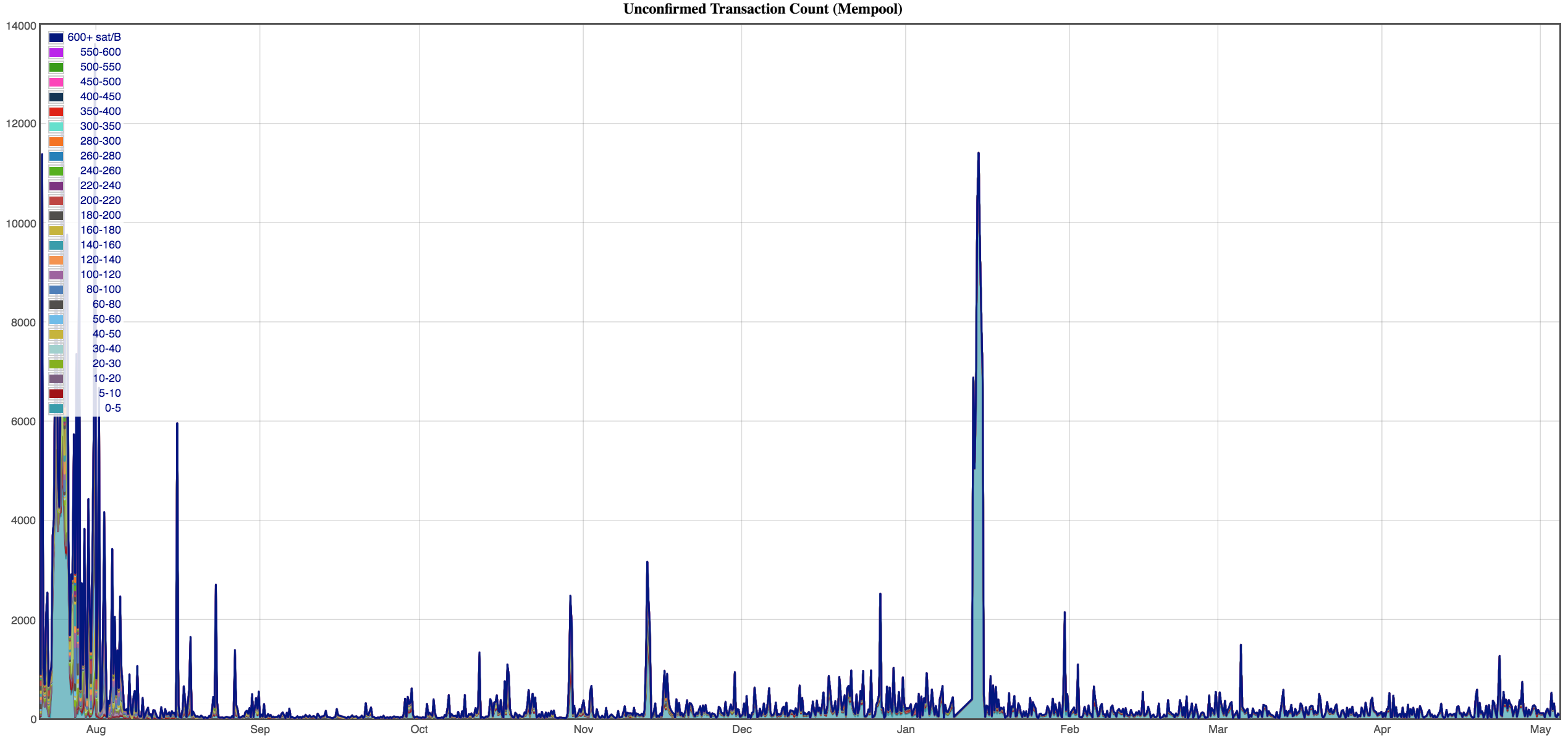
Mempool size, all else equal, is directly related to transaction fee size: a smaller pool of pending transactions means you don’t have to pay as much to get your transaction confirmed by miners. It makes sense, therefore, that BCH’s relatively small mempool size has led to relatively small transaction fees — typically on the order of $0.004 USD.
It’s worth noting that there are at least two reasons why BCH’s transaction fees could be low: large block size, or low demand. Since its 8-MB block size isn’t really getting used and the transaction number is low, this is currently a sign of low demand; but it’s hard to know now what this will mean for the cryptocurrency in the long run.
Bitcoin, on the other hand, typically has a mempool of around 7,000 transactions these days — far more than BCH’s.
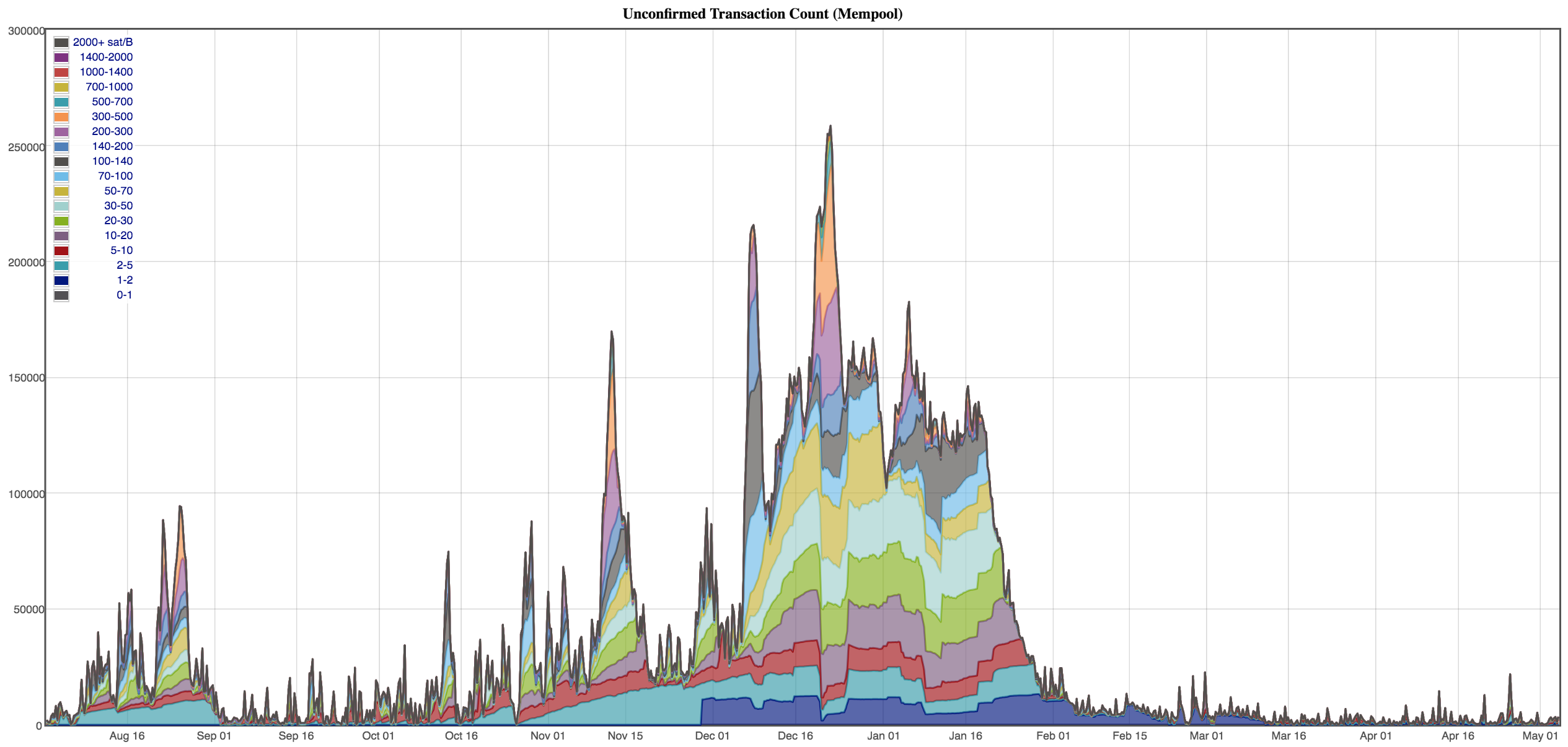
Bitcoin’s transaction fees, correspondingly, are far higher than BCH’s, with a median transaction fee between $0.15 USD and $2 USD.
With the higher fees and larger mempool that Bitcoin has, you’d imagine that more and more people would be flocking to Bitcoin Cash. And, although BCH hasn’t yet dwarfed BTC in the way some of its proponents expected it to, its transaction volume has roughly doubled from ~0.11 tps to ~0.22 tps.
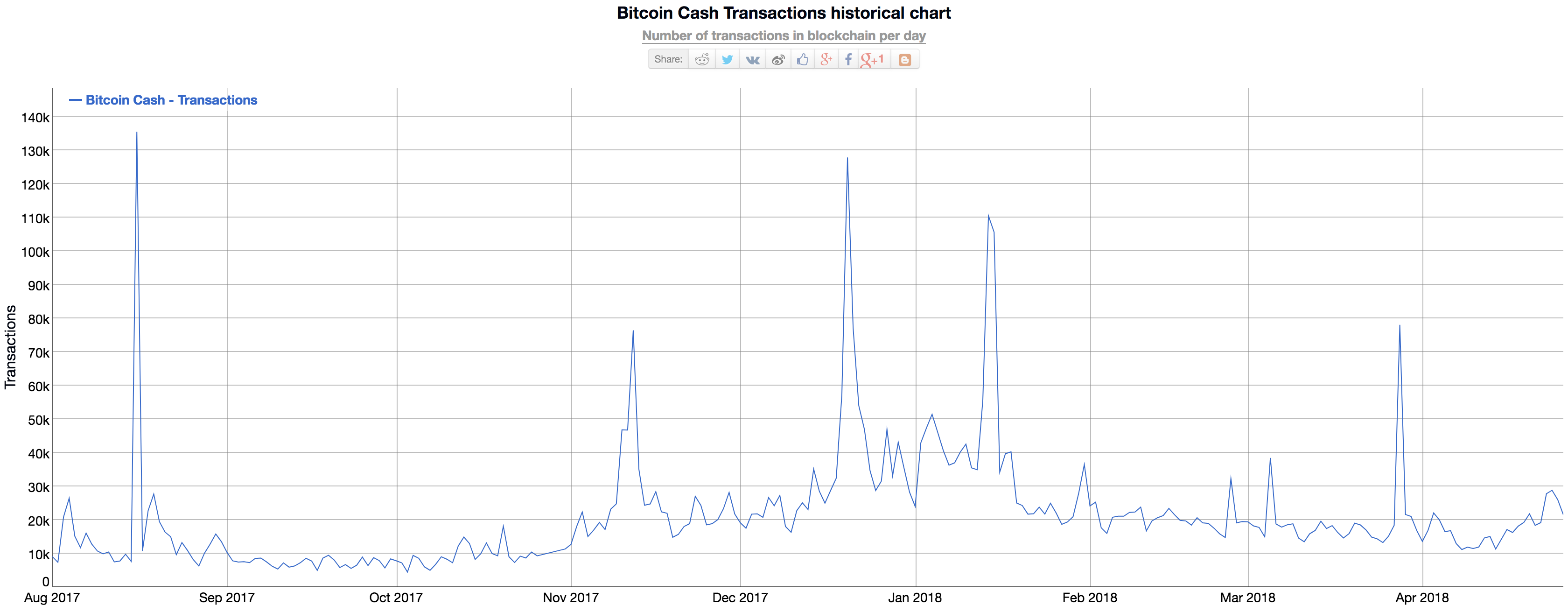
Bitcoin, on the other hand, has maintained a transaction volume that exceeds BCH’s by an order of magnitude.

Bitcoin has a median transaction fee between $0.15 USD and $2 USD, yet it continues to outpace Bitcoin Cash in terms of transactions. Bitcoin Cash may eventually prove itself as the new, decentralized PayPal, but for now, it doesn’t seem to have proven that it’s better suited for this task than Bitcoin is.
That said, it’s worth underscoring that the market seems to be rewarding BCH for its increased transaction volume. Just look at this table:
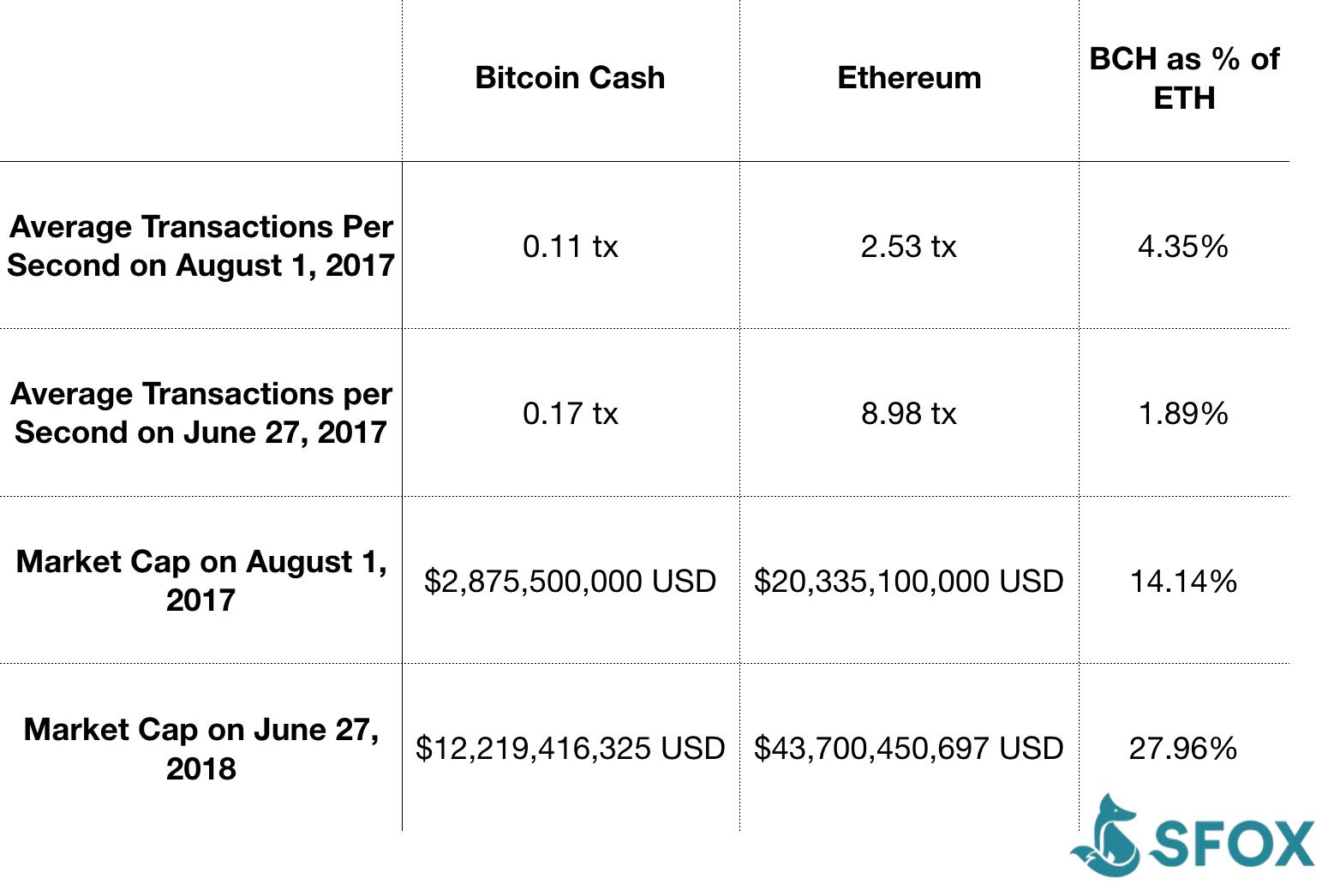
As BCH’s transaction volume has increased, its market cap has, too. Why might this be? It’s hard to say for certain, but chances are good that it has to do with the increase in merchants who are accepting it — a number that’s now greater than 100,000, according to Trustnodes.
Why might it be the case that BTC transactions have remained fairly constant, despite BCH’s increase in transaction volume and market cap? There are at least 2 possible explanations:
- It might be the case that most people weren’t using BTC for commerce in the first place. If BTC is primarily being used as a store of value — or as an instrument for speculation — then the smaller mempool and lower transaction fees of BCH wouldn’t be a compelling reason to move from BTC to BCH. In this case, the growth in BCH might be the result of a growing interest in crypto-based commerce.
- It might be the case that there just isn’t much interest in digital cash yet. People might be staying with BTC, rather than moving to BCH, because, for most people, debit/credit cards and cash work fine as everyday methods of payment. In this case, the growth in BCH might just be the result of broader speculation in the crypto space.
It may be too early to tell what the long-term value and uses of BCH and BTC are. But it certainly does seem that the market has recognized some distinct value in BCH: its market cap has increased almost 10x from the hard fork to now, compared to the 3.5x increase in BTC’s market cap, and BCH’s increased transaction volume seems like the most likely factor driving that outsized growth.
The mining swings have settled down
Both Bitcoin and Bitcoin Cash use the same hashing algorithm: SHA-256 and can therefore be mined using the same hardware, which initially led to a single pool of miners that would swing from mining BTC to BCH and back based on a simple principle: “follow the money.”
However, in recent months, the differential in profitability between mining BTC and mining BCH has decreased substantially, and so mining pools have been switching back and forth between the two cryptocurrencies less than before.
For both BTC and BCH, over half the new blocks are created by the same six pools:
- BTC.top
- ViaBTC
- AntPool
- BTC.com
- Bitcoin.com
- F2Pool
These pools choose what to mine based on the bottom line of what’s most profitable for them. Mining profitability is a tradeoff between how costly it is to mine a cryptocurrency (in terms of electricity costs, mining pool costs, how many other miners you’re competing with) and how much you can earn from it (in terms of fees and the cryptocurrency’s value).

Especially in the first few months of BCH’s existence, there was huge variation in the profitability of mining BTC vs the profitability of mining BCH. This led miners to oscillate back and forth between the two networks, which resulted in commensurate variation in BTC and BCH’s hashrate.

Notice that the atypical spikes in BCH’s hashrate through the end of 2017 correspond to moments when BCH mining was disproportionately more profitable than BTC mining.
Now, though, we’re seeing that the profitability of mining BTC and the profitability of mining BCH are much closer to each other than they used to be, and the hashrates have balanced out accordingly. In the past few months, we’ve seen both hashrates gradually and consistently increasing — which is what you’d expect, given the continued adoption of and interest in cryptocurrencies more broadly.
It’s worth noting, though, that the rate of increase in Bitcoin Cash’s hashrate has actually moderately outpaced the rate of increase in Bitcoin’s hashrate in recent months: since the start of 2018, Bitcoin’s hashrate has increased 97.35% from 15.0181E hashes per day to 29.6384E hashes per day, whereas Bitcoin Cash’s hashrate has increased 129.12% from 1.9669E hashes per day to 4.5066E hashes per day. If Bitcoin Cash does aim to outpace Bitcoin, it still has a ways to go — but it’s heading in the right direction.
The Future: Can Bitcoin Cash Coexist with Bitcoin?
Bitcoin and Bitcoin Cash have distinct long-term aims, and the subtle differences in how they’re already handling transaction volume and block size reflect those aims. Bitcoin Cash seems to be rapidly growing into its own kind of cryptocurrency, but it still has a long road ahead if it intends to reach the scale of Bitcoin.
Eventually, BTC and BCH may be able to peacefully coexist with different goals, with BTC acting like gold and BCH acting like PayPal — but BCH will have to grow far more before that possibility has a chance of being realized.
The above references an opinion and is for informational purposes only. It is not intended as and does not constitute investment advice, and is not an offer to buy or sell or a solicitation of an offer to buy or sell any cryptocurrency, security, product, service or investment. Seek a duly licensed professional for investment advice. The information provided here or in any communication containing a link to this site is not intended for distribution to, or use by, any person or entity in any jurisdiction or country where such distribution or use would be contrary to law or regulation or which would subject SFOX, Inc. or its affiliates to any registration requirement within such jurisdiction or country. Neither the information, nor any opinion contained in this site constitutes a solicitation or offer by SFOX, Inc. or its affiliates to buy or sell any cryptocurrencies, securities, futures, options or other financial instruments or provide any investment advice or service.
